I've decided to write a series of tutorials to show what goes into the creation of one of my skins. A lot of it is simply: /poke /poke /prod /prod “Hmmm, that looks good.†But I thought it would be interesting to do, nonetheless.
I’ll be going through my reskin of the Mithran THF AF. To start off with, I thought I’d go into detail on the planning part. (It also covers the most basic painting and modeling.)
In my thread on the Alla forums I got this request:
“Ok, time for me to put in my own request…I can't find is anything decent to replace my THF AF with. There just seems to be nothing out there that fits the THF spirit. In my desperation I even loaded up this one exotic dancer .dat collection and it was just way too skimpy, so I'm back to normal AF here.
So…could you cook up some THF AF .dats that don't make my poor Mithra look like a whore or as if she belonged up on a camel in a desert somewhere? :3 Would be greatly appreciated. I was thinking something sort of loose, in either the usual colors or possibly a red, showing a little skin/fur but not so much as to make me feel dirty. Maybe with a hairpin or circlet or beret in place of that awful bonnet thing, or even a ribbon.â€
Maybe with a hairpin or circlet or beret in place of that awful bonnet thing, or even a ribbon.â€
So the first thing I did was went and looked for some inspiration. Google is your friend for this stage. I also went and looked at some of the art on Elfwood (a huge online fantasy gallery). If you want, start gathering a file of reference photos and drawings. Any time something catches your eye, save it to that file. For example, on my computer, I have a file of costumes, a file for interesting shading effects, a file for folds (for cloth and such…I also put cool hairstyles there), and a file for poses (This isn’t really applicable to this situation, but I have it there for drawing practice.)
Here’s where you need to think of what exactly you’re planning to make. Ask yourself: “Is this going to be in the feel of the game? Do I want it to be realistic, modern, or fantastical? How much detail do I want? How much skin do I want to show?†I’ll address these questions more in later tutorials.
In my case, what it boiled down to, was, that the general feel of a Thief’s armor was something lightweight and darkly colored. Going off of this thought, I pulled out Model Viewer and started flipping through the models. While I looked for possibilities, I sketched out the first idea:

Now, I use my sketches to help come up with ideas. I have so many projects that I don’t want to forget any details that might come to mind. I’m not saying, “Oh, you don’t put any ideas onto paper? You noob!†It’s just the way my mind works, I think better if I put the idea down on paper, and I like to have plenty of sketches before I commit to a costume. You, on the other hand, may like to just start working and let the ideas flow. That’s okay too.^^
But I digress. Anyway…off of this first sketch I made the model that I’ve posed around the forums:
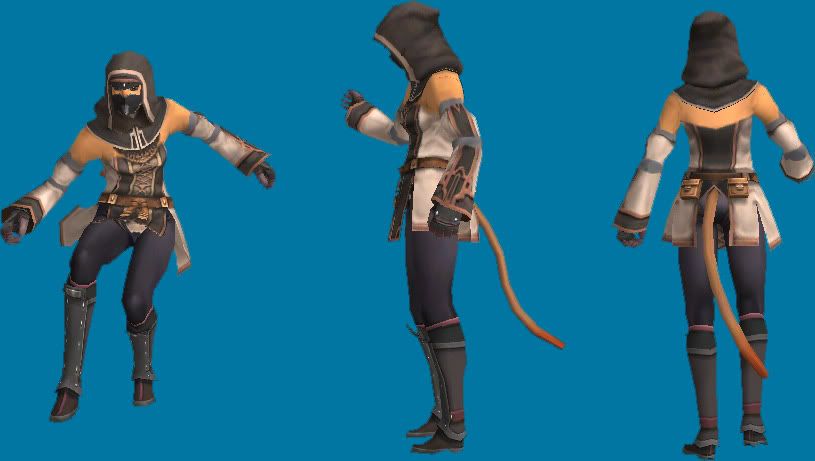
From there, I went to the /poke /poke /prod /prod stage. I wasn’t sure what I wanted the details to look like, and so I just started painting in the hopes of getting a flash of inspiration. I decided that the arms looked too thick to be bare, so I came up with the idea of leather armor under cloth.
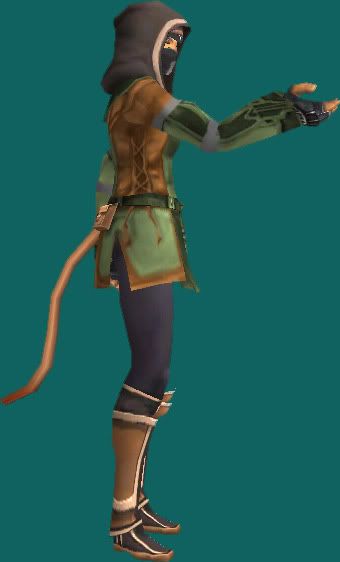
Ewwwwwwwww…..
Okay, well, I liked the lacing, and I liked the mask, and I liked the leather….but my mithra now looked like a refugee from Sherwood Forest. Great. Let’s throw that color scheme out the window and come up with a new idea.
Continued in next post...
I’ll be going through my reskin of the Mithran THF AF. To start off with, I thought I’d go into detail on the planning part. (It also covers the most basic painting and modeling.)
In my thread on the Alla forums I got this request:
“Ok, time for me to put in my own request…I can't find is anything decent to replace my THF AF with. There just seems to be nothing out there that fits the THF spirit. In my desperation I even loaded up this one exotic dancer .dat collection and it was just way too skimpy, so I'm back to normal AF here.
So…could you cook up some THF AF .dats that don't make my poor Mithra look like a whore or as if she belonged up on a camel in a desert somewhere? :3 Would be greatly appreciated. I was thinking something sort of loose, in either the usual colors or possibly a red, showing a little skin/fur but not so much as to make me feel dirty.
 Maybe with a hairpin or circlet or beret in place of that awful bonnet thing, or even a ribbon.â€
Maybe with a hairpin or circlet or beret in place of that awful bonnet thing, or even a ribbon.â€So the first thing I did was went and looked for some inspiration. Google is your friend for this stage. I also went and looked at some of the art on Elfwood (a huge online fantasy gallery). If you want, start gathering a file of reference photos and drawings. Any time something catches your eye, save it to that file. For example, on my computer, I have a file of costumes, a file for interesting shading effects, a file for folds (for cloth and such…I also put cool hairstyles there), and a file for poses (This isn’t really applicable to this situation, but I have it there for drawing practice.)
Here’s where you need to think of what exactly you’re planning to make. Ask yourself: “Is this going to be in the feel of the game? Do I want it to be realistic, modern, or fantastical? How much detail do I want? How much skin do I want to show?†I’ll address these questions more in later tutorials.
In my case, what it boiled down to, was, that the general feel of a Thief’s armor was something lightweight and darkly colored. Going off of this thought, I pulled out Model Viewer and started flipping through the models. While I looked for possibilities, I sketched out the first idea:

Now, I use my sketches to help come up with ideas. I have so many projects that I don’t want to forget any details that might come to mind. I’m not saying, “Oh, you don’t put any ideas onto paper? You noob!†It’s just the way my mind works, I think better if I put the idea down on paper, and I like to have plenty of sketches before I commit to a costume. You, on the other hand, may like to just start working and let the ideas flow. That’s okay too.^^
But I digress. Anyway…off of this first sketch I made the model that I’ve posed around the forums:

From there, I went to the /poke /poke /prod /prod stage. I wasn’t sure what I wanted the details to look like, and so I just started painting in the hopes of getting a flash of inspiration. I decided that the arms looked too thick to be bare, so I came up with the idea of leather armor under cloth.

Ewwwwwwwww…..
Okay, well, I liked the lacing, and I liked the mask, and I liked the leather….but my mithra now looked like a refugee from Sherwood Forest. Great. Let’s throw that color scheme out the window and come up with a new idea.
Continued in next post...




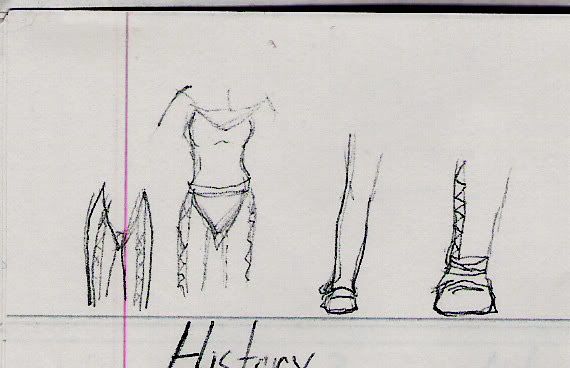

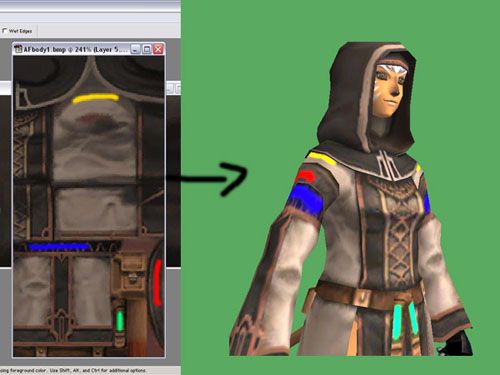
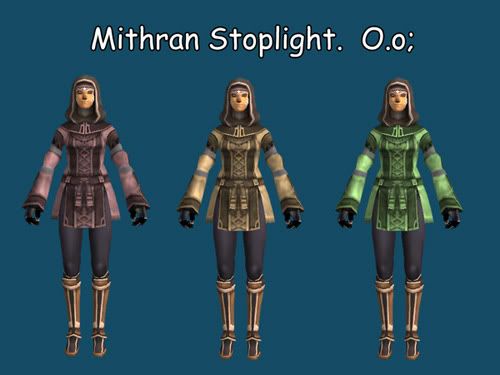
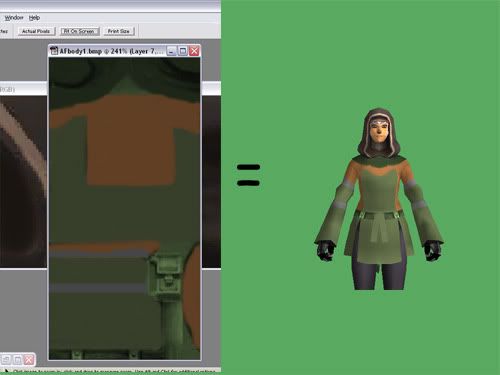
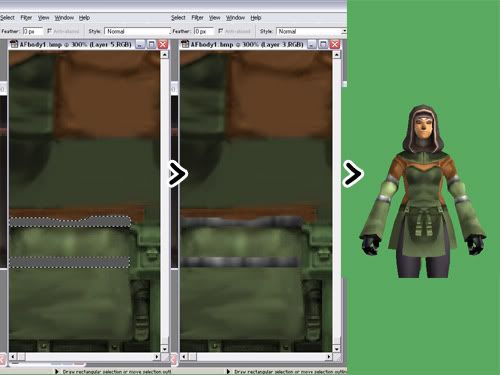













Comment